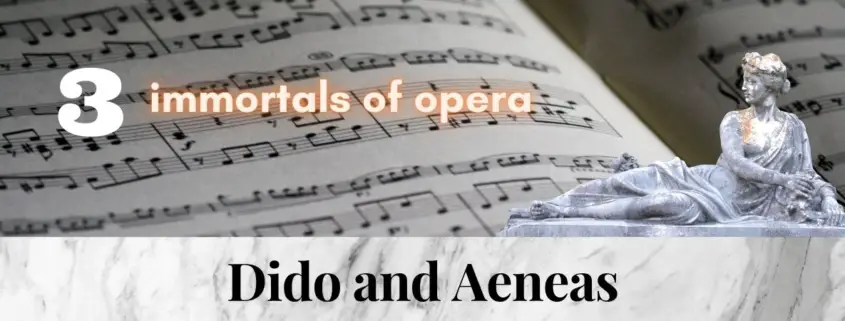Dido and Aeneas is the greatest work of the “Orpheus britannicus” Henry Purcell, who shows himself to be a master of the baroque form with this work. His lamenti are unsurpassed, his tone painting imaginative, his dissonances bold, and with “When I am laid in earth” he wrote one of the most beautiful arias of the entire baroque age.
Love for Aeneas unsettles Dido
Purcell obsessively uses a Baroque technique in this aria: to accompany this lamentation aria of Dido, Purcell has the basso ostinato (ground bass) motif repeated no less than 21 times.
We hear this aria sung by the legendary Janet Baker, who made her name mostly with oratorios and selected operas.
Ah! Belinda, I am prest with torment – Baker
With the witches
The witches want to know how this is going to happen. The sorceress explains that a spirit in the guise of Mercury will appear to Aeneas, and exhort him to seek out Italy and set sail. But first they want to cause a storm that will drive Dido and Aeneas from the forest back to their courtyard on the day of the hunt. The Furies perform a dance to celebrate.
This piece is also called “Echo Dance of the Furies” because Purcell has short choral passages repeated again and again by a choir in the background as an echo. A surprising and charming effect!
In our deep vaulted cell – Gardiner
Dido makes the cruel decision – the aria “When I am laid in earth”
Dido only wants to die. Once again she turns to Belinda, only to die by her own hand.
This aria is one of the great arias of opera literature, a lamento, a classic product of baroque opera. It is immensely effectively written and is one of the handful of baroque lamentos that can truly move the listener to tears.
Purcell wrote this piece tremendously effectively. He begins with a downward chromatic motif in the bass accompaniment that becomes a deeply sad ostinato and a constantly repeated motif (called “ground bass” in English):
At the end of the ostinato, Dido launches into her lament:
This melody impresses with many great effects. Particularly impressive: in contrast to the downward ostinato of the accompanying voice, Dido’s melody strives upward (from the g at “when” to the e at “no”) with leaps in tone (and subsequent downward notes), which makes Dido’s discord visible. Also contributing to the somber mood is the beautiful appoggiatura (foreshadowing) on the first “laid” (an added dissonance, foreign to the melody, that occurs on the stressed part of the measure and is resolved on the next note). We find another beautiful effect of the singing voice in the above note example in the somber tritone on “Trouble”
In the second part, Purcell introduces another element in the voice part, “Remember me,” which is enchanting for its simplicity.
With the final “Remember me,” Purcell lets the music soar to comforting heights before closing with “forget my fate,” which takes us into the depths of despair.
Perhaps the bleakest and thus most poignant recording is by Janet Baker. She sings the aria in a stifled voice that only opens up with the final bars, creating a great effect.
When I am laid in earth – Baker













Leave a Reply
Want to join the discussion?Feel free to contribute!